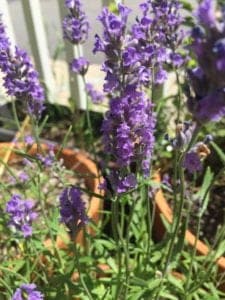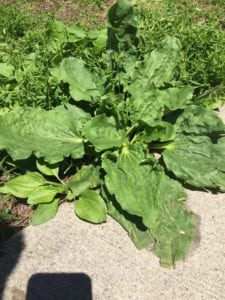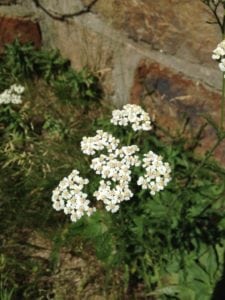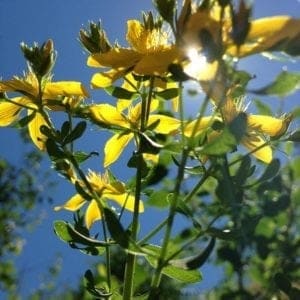Seven Herbs for Summer Health
Every season has its associated issues: in winter, I would say we can’t live without things like Thyme, Sage, Garlic, Onion – potent plants that get us through cold and flu season. Here are seven plants that will make your summer much more enjoyable!
Lemon Balm
Lemon Balm is my number one favorite plant for heat exhaustion. Part of the mint family, it grows prolifically, so have all you want! It’s a lovely plant, and smells and tastes delicious – less like mint and more like lemons: I definitely recommend growing some in every back yard! We love Lemon Balm when we do first aid medicine at summer festivals – it’s the first thing we give folks when they come in with heat exhaustion. It’s cooling and calming, and even has anti-depressant properties. Not only that, but it’s one of our best plants to fight cold sores. You can give it to anyone – little kids, elders, and everyone in between, and it doesn’t have any known drug interactions, so go ahead and put it in your water bottle on a hot day! If you have some growing near you, just clip off the leaves and stem, and brew it up for tea – it makes a great sun tea! If you don’t have any growing near you, you can find it pretty easily in stores, or online at www.mountainroseherbs.com.
Lavender
Everyone knows aloe is for sunburns, but sometimes the burn feels too hot even to smear on the aloe. Enter Lavender oil! Make up a spray bottle of water and 10 – 20 drops of Lavender essential oil, and spray it right onto sunburned skin – once you’re feeling cooler, you can apply aloe. You could even use Lemon Balm tea as the base of the spray for double cooling action, just don’t spray it on anything white!
But that’s not the only use for your Lavender essential oil – blended with olive oil or coconut oil, it’s also my favorite remedy for sore muscles. Rub it on sore muscles – a charlie horse, strained back, even tense neck and shoulders from spending too much time at the office and not enough time relaxing in the sunshine!
And for headaches that come along with heat exhaustion, put just a drop of your Lavender oil blend on the temples and the back of the neck, have a drink of Lemon Balm tea, and lay down in a cool room. You’ll still need to rest, but you’ll feel a whole lot better while you’re doing it!
Plantain
If you only know one plant in the wild, it should really be Plantain (the broad-leafed weed, not the banana). Plantain grows all over the country, and prefers packed dirt. If you have a dirt driveway, or if you hike on a hard-packed trail, you’ve certainly seen Plantain. Good thing it lives everywhere, too, because you can use it for absolutely everything! Burns, cuts, bee stings, itchy or painful bug bites, spider bites, abrasions – even splinters that won’t come out! You can pick it raw wherever you are when you need it, or make it into oil or tincture so that you always have some on hand.
Plantain “draws” things out, whether a splinter or bug “venom”. Bruise up the leaf a bit and rub it on a bug bite to relieve itch, or lay several bruised leaves over a bee sting or a spider bite to relieve pain (you can secure it with a bandana or bandage). For a splinter, fold a leaf up and hold it on with a bandaid overnight – in the morning, the splinter will have pushed out enough that you should be able to grab it with tweezers.
Plantain’s drawing action also can disinfect wounds – again, bruise the leaf up enough to let some of the “juice” seep into the wound. If you’re camping and have a stove, you can also boil the leaves into tea and soak a cloth in it to make a compress. A big part of this is due to its biofilm disrupting action – though that’s probably not the end of the story!
We like to make oil from the plantain – you could make a tincture too, but oil has all the same properties, and doesn’t sting on a cut or wound – which my daughter greatly prefers! There are instructions at the end of the article for making an oil: it’s a great project to do with kids!
Calendula
Calendula is the herbal name for pot marigold. It’s not only good at keeping pests off your tomato plants, it has a whole host of medicinal actions! Calendula is commonly made up into an oil or salve, and is useful for just nearly anything that happens to your skin. Campfire burns, any kind of cut or abrasion – if it’s on your skin, Calendula can help. Not only that, but Calendula has disinfectant properties, and is great for moving lymph and stagnant blood – which makes it great for soothing those varicose veins you don’t want to show off while you’re walking around in shorts.
Instructions for making an oil are at the end of the article – for Calendula, use the flower tops – though many pre-made preparations are available in various health food stores. You’ll often find it combined with Plantain for double skin-healing action!
Yarrow
Yarrow is a pretty plant that grows in lots of places. It’s particularly good for sweating out a fever, but the application that we usually want it for in summertime is bleeding. Yarrow helps restore homeostasis to the circulatory system. If you’re bleeding from a wound, the pressure in your blood vessels has changed – much like if a spaceship’s hull is punctured and oxygen is leaking out into space. (How did we possibly describe herbal actions before science fiction?) Yarrow helps to stop bleeding by re-normalizing the pressure throughout the body, so that you don’t vent all your oxygen out into space – I mean, bleed to death.
Yarrow is also disinfectant – if you’re on the trail, you can actually just bruise up some yarrow flowers and put them right onto/into the cut – it will stop bleeding very quickly and keep the wound from getting infected. In case Yarrow doesn’t grow near you, you can carry a tincture bottle of yarrow with you when you’re hiking, or if you’re prone to nosebleeds, or if you’re the mother of boys and girls with scraped knees and elbows. You can also apply Yarrow tincture directly to the wound, but it will sting because of the alcohol. You might prefer Yarrow oil instead to use in that way, but you will probably have to make that yourself (use the Plantain oil directions at the bottom). The tincture is widely available.
Yarrow is also quite handy for varicose veins – you can blend it with Calendula for this purpose. Used together over time, they do an impressive job of shrinking the veins back down.
St. John’s Wort
St. John’s Wort is a very handy little plant. Great for soft tissue damage and nerve damage, a bottle of this tincture is a must for all weekend warriors. Apply the tincture directly to bruises, contusions, sprains, strains, or the place in between your thumb and forefinger where the frisbee whacks you every time you catch it. St. John’s Wort will heal it up quickly! In any of these cases, there’s damage to the nerve cells as much as there is to the muscle tissues and tendons – and this is where St. John’s Wort really shines. St. John’s Wort helps to remyelinize the nerve endings, as well as to help regenerate damaged nerves.
It’s not just for weekend warriors, either – it’s quite handy for MS, fibromyalgia, shingles, and any other nerve pain. In the case of shingles, St. John’s Wort, like Lemon Balm, has a special affinity for the herpes family of viruses – chicken pox, shingles, cold sores, warts, and actual herpes. Take it internally and externally!
St. John’s Wort is one plant that is best not taken in combination with prescription drugs, as it can speed the metabolism – much like grapefruit. It won’t interact with the drugs, but it will cause them to move more quickly through the system. If you’re on a time-release type of prescription, or any medication with very precise dosing, then just use St. John’s Wort topically.
Meadowsweet
Although many people are familiar with arnica, I much prefer Meadowsweet for pain. Meadowsweet is one of the original plants used to make aspirin, but when taken as a plant, instead of isolated compounds, Meadowsweet does not have the unpleasant side effects of aspirin. You can take it internally as a tea or tincture, but my favorite use is topically – buy it as a tincture and just rub a few drops on areas that pain you. Not too much though! Pain serves a purpose – usually to let us know that we’ve had enough and need to rest. When you use too much of any kind of pain killer, you’re liable to do something stupid (like head right back into the touch-football game!). Use Meadowsweet to take the edge off the pain, but leave yourself enough so that you remember to stay put until you heal up!
If these plants don’t grow near you, you can purchase them at www.mountainroseherbs.com, or at your local healthfood store. Have some of each on hand and breeze through your summer!
How to Make Plantain Oil
(or Calendula, or St. John’s Wort, etc…)
You can use Plantain Oil all year round to keep the medicine of Plantain close at hand! In the winter when you can’t find Plantain outdoors, you will have your bottle of deep green oil to help you inside and out! Making Plantain Oil is easy and fun!
You will need:
a clean jar with a lid
olive oil
plenty of clean, fresh Plantain leaves
How to do it:
On a sunny day, go outside and pick enough Plantain leaves (or Calendula flowers, or St. John’s Wort flowers, or…) to fill your jar. You will know for sure you have Plantain when you see the broad leaf and feel the strong cords coming out from the stem to the tip of the leaves. Look for the cleanest leaves, without brown spots. Try to pick leaves that haven’t been eaten up by bugs. Make sure to pick in a clean area, where no chemicals are sprayed.
Take your leaves inside, and brush them off carefully. Wipe off any bits of dirt or little bugs that might have come in with your harvest. Double check each leaf to make sure it really is Plantain, and that it looks great.
If the leaves are wet, let them sit on the counter for a little while to dry off and wilt just a bit. This way, you won’t get water into your oil: that could cause mold.
When they’re a little bit wilty, and any water is dried away, tear each leaf into a few pieces and put it in the jar. Make sure the jar is filled – don’t pack it down too tightly, and don’t leave it too loose: just fill it so that it comfortably holds as much leaf as it should.
Now pour the olive oil into the jar. Watch it dribble down into the spaces in between the bits of leaves. Sometimes it leaves air bubbles – shake the jar gently to let the air bubbles escape. Fill the jar just nearly to the top with olive oil, so that all of the leaves are covered, and put the lid on tightly. Make a label for your jar that says Plantain Oil, and the date.
Set your jar in a place you’ll see it every day. You might put it near your bed, or on your desk, or on the kitchen counter. Don’t open your jar! Leave it closed for four weeks so that all the medicine from the Plantain can come out into the oil, and so that no mold or dirty fingers get into the jar. You can shake it gently each day if you like, and you can watch it as the oil changes – it will become a darker and darker shade of green as time goes by! This is the Plantain medicine coming into the oil.
After four weeks, open your jar and pour the oil out carefully, through a strainer into a clean jar. You now have beautiful green Plantain Oil that you can use anytime you have a cut, a burn, a bite, or any dry itchy skin. You can also eat a spoonful of the oil to help you when you have a cough, or if your guts are feeling crampy. There are so many uses for Plantain Oil!
this article was originally written for mommypotamus.com

Join our newsletter for more herby goodness!
Get our newsletter delivered right to your inbox. You'll be first to hear about free mini-courses, podcast episodes, and other goodies about holistic herbalism.







